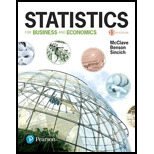Solutions for Statistics for Business and Economics (13th Edition)
Browse All Chapters of This Textbook
Book Details
For courses in Introductory Business Statistics.Real Data. Real Decisions. Real Business. Now in its Thirteenth Edition, Statistics for Business and Economics introduces statistics in the context of contemporary business. Emphasizing statistical literacy in thinking, the text applies its concepts with real data and uses technology to develop a deeper conceptual understanding. Examples, activities, and case studies foster active learning while emphasizing intuitive concepts of probability and teaching readers to make informed business decisions. The Thirteenth Edition continues to highlight the importance of ethical behavior in collecting, interpreting, and reporting on data, while also providing a wealth of new and updated exercises and case studies.
Sample Solutions for this Textbook
We offer sample solutions for Statistics for Business and Economics (13th Edition) homework problems. See examples below:
More Editions of This Book
Corresponding editions of this textbook are also available below:
